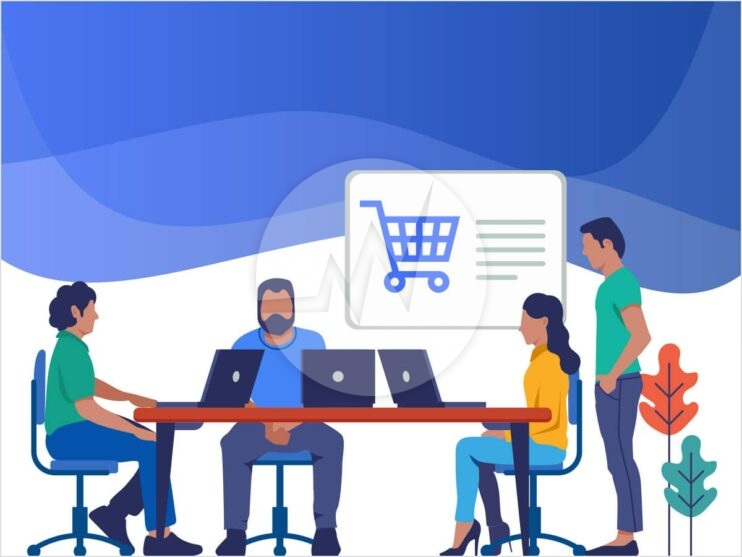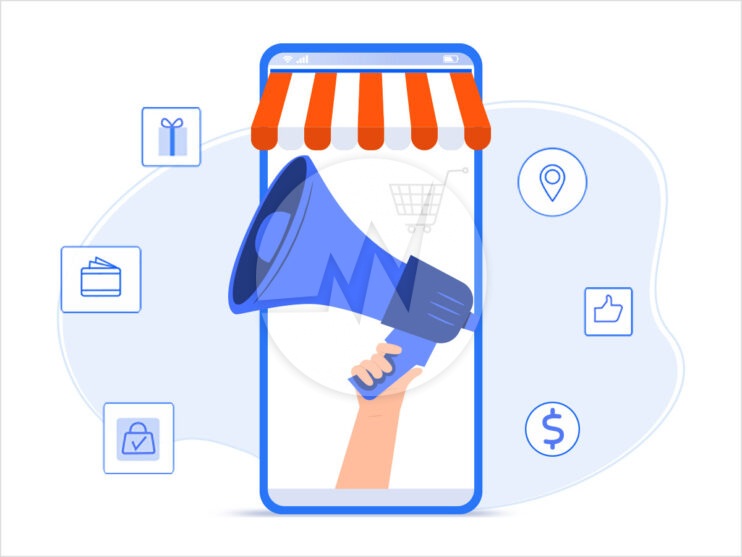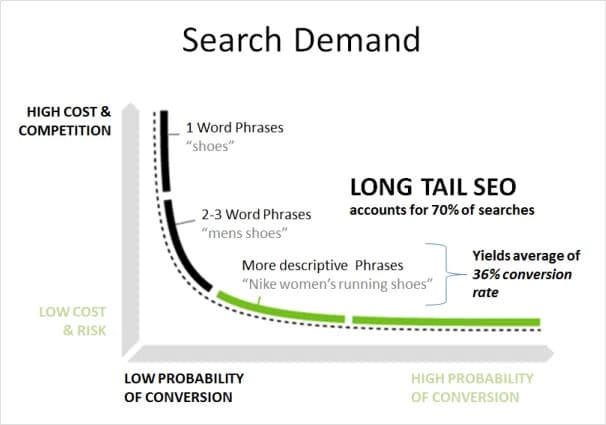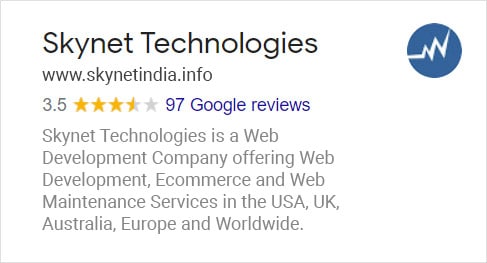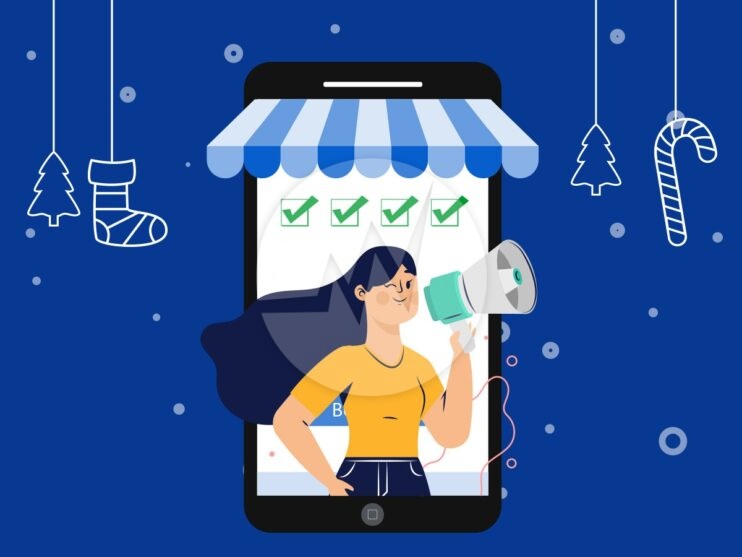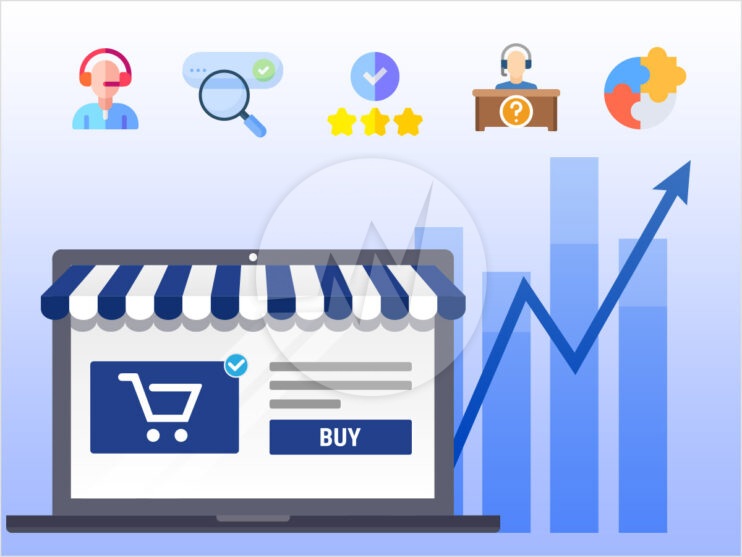The most important Ecommerce marketing services
A marketing channel is a source or a meaningful group of sources through which a website operator generates visitors for the website. A marketing channel is selected depending on the range. Many companies operate multi-channel marketing and use all possible methods to create brand awareness and acquire customers. Below we present the most important channels that you should definitely know.
Price comparison
We all know from experience that websites get the most clicks on the first page of search results. But: What do you do when the top positions in the search engines have already been assigned to price/comparison search engines? Don’t fight, join in!
Users of price comparison portals have already made the decision to buy a product and are looking for the best price. With the countless number of portals, it has never been easier than it is today. From flight and hotel prices to electronic devices to food, these days you can compare the prices, delivery conditions and payment methods of the providers before buying and it is easier for retailers to decide whether to buy the product. This is your chance as an ecommerce retailer to provide best ecommerce marketing services to acquire customers.
Attention: It is unfortunately not enough to offer your products on various price search engines. If your ecommerce store does not offer the cheapest price, your product will never be at the top of the comparison lists. The cheapest price is the most important criterion for being seen by buyers on online portals.
Search engine marketing (SEM)
As a Search Engine Marketing placement is referred to by links that are found on the search engine results pages. A distinction can be made between organic search results and the placement of paid advertisements (sponsored search).
In order to improve your own website in the organic search results, measures must be continuously taken to increase the relevance perceived by the search engine. The implementation of these measures is called search engine optimization, which can be divided into so-called on-site and off-site optimizations.
The business model of search engines is based on the placement of advertisements. The price model used in sponsored search is called cost-per-click (CPC) or also pay-per-click (PPC). Here offer the advertisers on samples of specific search terms (keywords), where ad to appear above or to the right of the search results, and places a maximum cost per click (max. CPC fixed). The click-through rate (CTR) is the number of times people who see your ad click on it. You can use this metric to gauge the performance of your keywords and ads.
CTR = clicks / impressions
Paid advertising on Google
Many new ecommerce stores start with this marketing channel, as paid advertisements instantly boost website traffic. However, there are ways that boost traffic on your ecommerce store organically, but that takes time. Ecommerce store owners can get their first customers immediately after the ads have been approved. We further explain what types of paid advertising there are on Google and what you need to consider.
Various factors influence the speed of customer acquisition with SEM:
- The longer you consider whether to start an advertising campaign, the more delayed the first customer contacts and sales.
- Traffic volume – the smaller the volume at the start, the longer you wait for the first customer.
- Your offer – non-competitive offers do not generate any sales despite high advertising budgets.
Every ecommerce store is as individual as its marketing strategy. For ecommerce store that sell technology, for example, it is important to use keywords with a low search volume at the start. The advertising budget is limited, the competition is high, but CPC and conversion are bad. As your sales and advertising budget increases, you can expand your advertising campaign on Google with the short-tail keywords.
Google shopping
Google Shopping is a somewhat different price comparison portal. It offers online retailers the opportunity to advertise their goods directly via the Google product search. Since 82% of potential buyers search for their product requirements on Google first in order to find the best supplier, it is advisable for ecommerce store operators to actively use Google Shopping.
The sales aspect is even stronger with Google Shopping ads than with classic search ads. At the moment of the search, shopping ads present the user with specific products with images, prices and availability. Regardless of whether a user actually just wants to get information or has a specific intention to buy: We enable them to make a purchase decision immediately. For some retailers, Google Shopping is the marketing channel with the highest sales and, in addition to brand campaigns via classic search ads, a central sales driver.
Ecommerce store operators register a Google Merchant Account for this, provide their product list there and should update it regularly. Then Merchant Center and AdWords are linked and the merchant creates a separate shopping campaign. The billing model used for Google Shopping is also CPC.
The product list is used to display the product advertisements. When creating the product titles and descriptions, use the brand names and other words that customers are looking for.
Very important: Include the most important information in the first 25 characters.
No keywords are required for the ads because the product list is used. However, you can exclude search terms. The more relevant information the feed contains, the better it will be rated by Google.
You should put a lot of care on the pictures. Large, high-resolution product images ensure better perception for the user. Exempted products have a higher quality effect.
Google Ads PPC text ads
It is well known that the PPC text ads from Google Ads (formerly Google AdWords) get by without images.
In order to land at the top here, advertisers need to achieve a high-Quality Score for your ad. Because Google determines how relevant the ad group is to visitors. In addition to the ad text, the search terms (keywords) and the landing page, particularly clever and strategic keyword bids are required here.
Long-tail keywords are usually better for targeting customers. Above all, they address buyers who have already dealt with the desired product and are therefore looking for specific details.
In order not to generate unnecessary clicks (only you pay for them), a good keyword diagnosis is important. This can also help to make optimal use of the “matching phrase” or “largely matching”.
Tips for PPC campaigns
It is also good for clicks, ad rank and conversion to use the ad extensions for PPC campaigns.
Clever retailers don’t just fill the space for text with advertising promises and keywords. They also offer additional information about the service, or for example a free shipping offer.
Google Ads offers a wide variety of extensions. The following are particularly successful:
- Call extensions: This allows customers with smartphones, for example, to make a call with just one click.
- Location extensions: With this you can add the address, phone number and a map marker.
- Rating enhancements: According to Google, the feedback from other customers can increase the click rate by up to 10 percent.
Up to three ad extensions are used by Google at the same time. As you add more, Google automatically and dynamically applies a selection.
Google can now also automatically create ad extensions if the algorithm predicts that an extension will improve the performance of the ad. There are currently seven types of automated extensions available:
- Automatic call extensions
- Automatic SMS extensions
- Dynamic sitelink extensions
- Dynamic structured snippets
- Automatic location extensions
- Automatic ad extensions with seller ratings
- Dynamic extensions with additional information
When it comes to ad texts, there are always little things to improve or variations to test.
Experiment with unique selling points. This is how you can find out which unique selling point works best for your online target group.
Experiment with different verbs in a call to action (“test” or “discover”). Play with the representation of numbers (1 million or 1,000,000). Sometimes such small changes will noticeably improve the click rate.
Display Advertising
So-called display advertising (also display marketing or banner advertising) refers to advertisements that can usually be found in the form of banners on websites. It is also possible to display text ads instead of banners or videos.
The banners serve as a link to the advertiser’s website. Banner advertising is used to increase sales, increase awareness or for branding purposes.
The latest developments in targeting and retargeting make an important contribution to this.
In order to place your advertising, you can book the desired environments on websites that are relevant to you. Your ad banners will then appear on these themed websites. The contextual relevance ensures that the user is “picked up” very well and does not see any off-topic ads, which significantly increases the number of clicks compared to generic and randomly placed advertising.
The banner should convey its message briefly, concisely and credibly, since the user’s eye only lingers on an advertising banner for around 1.5 seconds on average.
The appeal of banner advertising is assessed on the basis of the percentage of clicks in relation to the general views on the operator’s website (CTR).
SEO for Ecommerce Store or Ecommerce Website
The potential buyers who land on your ecommerce store via organic sources – i.e., search engines like Google and Co. – are an indispensable source of sales. SEO for eCommerce drives traffic to your web store and provides you with visitors. You can follow On-page SEO for eCommerce to bring more organic traffic to your store.
Compared to paid advertising, you build a foothold for continuous, free traffic that lasts even after the advertising ends.
The websites that appear on the first page of search results get the largest number of clicks. There is no “simple” and certainly no general answer as to how a page position itself in the top 10. But with the necessary know-how and a well-thought-out concept based on experience, it is definitely possible.
Technical aspects
Your ecommerce store must always be comprehensively optimized so that the search engine is suggested to be highly relevant to certain keywords. This requires an individual concept consisting of On Page and Off Page measures. Since Google changes its ranking algorithm almost every day, this represents a multifaceted challenge.
Keywords
An ecommerce store is a website with several subpages. Each side has the same goal. There are only two types of pages that improve SEO traffic:
Product page:
Contains the most important product information, meta tags are product-oriented.
Category page:
Enables you to generate traffic even with keywords with a low search volume.
Actually, the category pages consist of keywords with high search volume, and the keywords with low search volume form the product names and are used on the product page. But that way you can lose subordinate categories. In this case, it makes sense to focus on keywords with a lower search volume. The search volumes initially appear unattractive. But you can achieve a top position in Google with less effort. In most cases, you also cover other long tail keywords with this page. Another advantage of so-called longtail keywords is that they are much more specific than generic keywords such as “women’s fashion”. A page optimized for a longtail keyword usually answers a searcher’s search intention much better.
Taken individually, long-tail keywords bring few visitors. In total, a large number of long-tail keywords will bring you much more than a handful of short-tail keywords on search results page 3.

Keywords that are searched frequently can bring you more traffic. However, keywords with high search volume are often associated with strong competition. For this reason, it makes sense to consider keywords with little or no search volume.
SEO texts
The ecommerce store that have not managed to create a good structure try to write the SEO texts.
Mistake number 1: you write SEO texts under the product catalog, in the sidebar, try to hide the text blocks, reduce the font size; In the end, an ecommerce store looks like this:
Better to write a blog or reserve an area on your website for important information. Create a so-called keyword map of all the search terms that are associated with your product and write general tips in a blog post. Instructions for use, instructions, questions and answers, everything that the customer could look for before or after the purchase – ends up in the blog of your ecommerce store.
Make sure that the SEO texts are reader-friendly. Gone are the days when search engine crawlers only calculated the ranking based on the number of keywords. The algorithms are constantly evolving (AI) and do not accept pages that only consist of keywords and have no real added value for the user.
The information provided on the ecommerce store page must be helpful for the user from several points of view or it must create added value for the purchase or decision-making process of a product and that in your ecommerce store.
Title and Description
The meta title is an important ranking factor and there are a few rules that you should follow when using it:
- Each page has a unique title (meta title)
- No duplicate content in the meta title
- The meta title is not a combo-separated series of keywords (good readability)
- Pages that should not be indexed are excluded with the tag “noidex”
Important: Meta Title and Meta Description are automatically “generated” by the search engines if they are missing.
The Meta Tag Description has so far, no influence on the ranking, but is prominently displayed to users by the search engines. Take the chance and write a short sentence that arouses the interest of the user. To be sure that your snippet is displayed correctly, you can add to your source. This prevents the automatic generation of descriptions.
Generate higher number of clicks through structured data
Structured data
(microdata): Tell the search engine additional information about what is on the page. While people can extract such information from the given context and unconsciously build such links, search engines have to be taught this context.

Structured data is a fine thing, because such a structure can be an advantage over the competition. Not only can the search engines understand and classify your content better, but also the user becomes aware of your offer thanks to a strikingly good structure and presentation. Structured data have no direct influence on the ranking, but have an indirect effect on the ranking through a higher click rate. Structured data and SEO – go well together.
There is no guarantee that Google will display your structured data as a rich snippet, even if the markups have been entered correctly. Indexing structured data takes longer than text or URLs. The indexing process can take up to a week.
Common mistakes
After ecommerce store is online, many ecommerce store operators think that they should definitely reach number 1 in the search engines and therefore only invest in SEO. The hope is that you no longer need an advertising budget and the ecommerce store will then generate paying customers “as if by itself”. Unfortunately, this is not true. SEO is a tedious (good, stable results after 3-6 months) and continuous process that requires a lot of effort and is never finished.
Search engines are constantly evolving, changing their guidelines, your competition never sleeps and so it is becoming more and more time-consuming to keep “1st place”. Sometimes it takes up to 12 months to cover pure SEO costs. That is why you always use a multi-channel strategy (marketing mix).
Social Media Marketing (SMM): What do social media bring for my ecommerce store?
The short answer: attention. Social media offer enormous potential for ecommerce stores to be seen by the respective target group and to guide customers into the ecommerce store through appropriate content. In addition to attracting attention, the social networks can also charge the brand and even generate direct sales. Check out the guide on how to build the Right Social Media Marketing Strategy for your business!
For many people, social media is an opportunity to immerse themselves in other worlds and discover new things without leaving their own couch. Make you want something new and arouse the longing for and the need for the products in your ecommerce store.
The more natural and authentic your social media content is, the less you appear as a disruptive advertising factor in your customers’ feed. The more present you are on social networks and the bigger your ecommerce store is, the more important the topic of social media customer service will become. Individual answers to questions and complaints can work wonders and turn dissatisfied buyers into fans and fans recommend you to others.
Achieve customer loyalty and conversions through email marketing
Customers who regularly shop in your ecommerce store are highly significant and the best recommendation for your company.
Therefore, email marketing should not be missing in your marketing mix. With the consistent construction of a distribution list and the regular dispatch of well thought-out, individualized newsletters, significant sales can be generated.
Frequent “arguments” that ecommerce store owners advise against email marketing:
- Email marketing is spam, customers don’t care
- For email marketing you need a large number of subscribers, otherwise it doesn’t work
- Email marketing contains sales information only
- You have to send out newsletters very rarely or every day
Email marketing is evolving and many processes can be automated. Analysis tools make it possible to find out whether your newsletter has been read, whether the links have been clicked, whether the people who read the e-mail have bought something in your ecommerce store. With this knowledge, you can adjust your marketing strategy and measure its success.
Email marketing is not a sender one-way street. Goals and benefits:
- Converting a lead to a buyer
- Customer loyalty
- Targeted communication with premium customers
- Reactivation of former customers
- Help in building brand loyalty and brand loyalty
Actively offer your customers to subscribe to the newsletter. In this way you can collect a pool of interested parties within a few months. The automation of email marketing is efficient for all ecommerce store regardless of how long a store has existed. The number of subscribers increases the chance of greater traffic generation, but not only quantity, but also quality counts. The sooner you implement this marketing channel, the better.
The following types of emails can help you develop a sustainable email marketing strategy with great results:
- Registration/forgotten password: Service e-mails do not have to end up in the “Spam” folder and must also have a corresponding design. You can send the welcome message with the following content: a personalized greeting, a brief introduction to your product, brand or service, a call to action that redirects you to your website or provides you with free and interesting content.
- Order: Classic notification that the order has been confirmed. It is useful to place the links that lead to pages with FAQs and instructions.
- Bonus / discount codes / vouchers: generate one-time or regular special offers. In this way you can arouse interests in different products or product groups.
- Birthday / public holiday: show your attention by congratulating your customers on public holidays and giving away an individual discount code.
- Sale offers / promotions: Inform your customers of promotions and savings offers.
- The product is in the shopping cart: If the logged-in customer has added something to the shopping cart but has left the ecommerce store without making a purchase, send a small reminder note.
- Reactivation mail: e-mails with an attractive offer to customers who have not bought anything from you for 1/3/6/12 months.
- Building brand loyalty: Personalized messages for premium customers with special offers.
- New blog post: Let your subscribers know when you write something new on the blog. Warning: only send this e-mail to those customers who have subscribed to such a newsletter, because this type of e-mail is the most annoying for the majority.
- Questions after the purchase (after sales): Ask your customers for a rating (on your website or on a comparison / rating portal).
Marketing campaign analysis
In order to use your time and budget wisely, campaign planning should go hand in hand with your digital marketing strategy. Campaign analysis is important to achieve success in the future and avoid failures. Web analysis tools help with this.
Google Analytics is without a doubt the most powerful, free web analysis tool for websites and ecommerce stores. The goal formulated by the company behind the website must be measured in Google Analytics. As long as this measured value is not available, meaningful conversion optimization is impossible.
To measure conversion, you need to set up goals in Google Analytics. You need to be able to measure the number of end customers. The easiest way is to compare the number of ecommerce store visitors with the number of users who have visited the “Thank you for your order!” Page.
With the help of the ecommerce reports you can analyse the buying activity on your ecommerce store. The reports include product and purchase information, average order value, e-commerce conversion rate, time to buy, and other information.
Regularly monitor the figures from Google Analytics, it will help you to find out more from your customers and effectively adapt your marketing strategy.
Conclusion
Marketing for an ecommerce store is a multi-stage process. If you break it down into small tasks, you can develop your ecommerce store strategically.
Communicate with your existing customers. Work on customer loyalty, because customer acquisition costs a lot of money and time. The first transaction of a new customer does not cover the advertising budget, so you have to actively take care of winning him as a regular customer.
To avoid unnecessary marketing, SEO, design, and web development costs, turn to the pros. Skynet technologies will be happy to answer any questions you may have! Well, Ecommerce marketing Services will give your business a new height and meticulously transform your business.
If you are looking for ecommerce marketing services, ecommerce digital marketing, digital transformation, content marketing, effective search engine optimization, online marketing, social media marketing, digital marketing strategies, search engine optimization services, PPC campaign management services and more, Please Explore our SEO Services!
